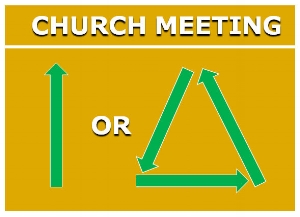Activating Unused Church-Building Tools
In church-as-usual, the majority sit, watch, and listen as onlookers, sightseers, bystanders. Traditional formats have taught most in the room to stay silent while a few others exercise their gifts from the platform. Old habits die hard. So, any movement toward a shared-church agenda must be done gradually and with care. In this and the next few blogs, I’ll explore how to help prepare God’s people to meet in more participatory ways.
What must benchwarmers have to become active players in a church meeting? They will need a new (and perhaps untapped) source of strength, energy, and wisdom—a source God supplies for Christ-followers. Because Jesus died, God has forgiven our sins. Because Jesus returned to his Father, he has given us the live-in Holy Spirit. Now and then in the Old Covenant, the Holy Spirit “came upon” people to empower them for special tasks. In the New Covenant, God has “poured out” his Spirit on his servants (Acts 2: 17, 33). The Holy Spirit is actually “in” them (Jn. 14:17). How does all this relate to shared church?
This Holy Resident moves in bearing gifts. Not gifts in the sense of Christmas presents given to please the receivers. Instead, these gifts are more like the tools contractors provide for their crews. God’s Spirit gives his gifts so that we may join Jesus in completing his construction project—the building-up of the Body of Christ. As Paul urged the believers in the church at Corinth, “try to excel in gifts that build up the church” (I Cor. 14:12). In their church meetings, they were to bring out their gift-tools and use them “for the strengthening of the church” (v. 26).
That worked in New Testament churches. But today, thanks to centuries of learned passivity in church meetings, many believers have little or no idea of what their Spirit-given gifts may be, let alone how to use them. Back in 2009, the Barna Group, specialists in conducting research in churches and among Christians, reported their findings from a survey on spiritual gifts. They found that “between those who do not know their gift (15%), those who say they don’t have one (28%) and those who claimed gifts that are not biblical (20%), nearly two-thirds of the self-identified Christian population who claim to have heard about spiritual gifts have not been able to accurately apply whatever they have heard or what the Bible teaches on the subject to their lives.”
What explains this ignorance of spiritual gifts and the inability to use them? In some cases, the lack of clear teaching may lie at the root of the problem. But another factor also plays a major part. How much opportunity does the typical church meeting offer for practicing the use of the Holy Spirit’s gifts? The saying, “Use it or lose it,” may shed some light here. Non-use of our gifts can surely cause us to lose sight of them.
In Curing Sunday Spectatoritis, I say, “Imagine the results if construction workers were given cordless drills, pneumatic nail guns, and circular saws and told how the tools worked—but without any opportunity to practice boring holes, driving nails, or cutting two-by-fours. An apprenticeship in carpentry includes both teaching about the tools as well as hands-on experience in using them. Discipleship in following Jesus and learning to help build his church should also include carefully structured opportunities to practice using the Spirit-given gifts.”
But the traditional non-participatory church meeting encourages believers to leave their gifts in the unopened tool box. In his book, The Reconstruction of the Church—On What Pattern? E. Stanley Jones wrote:
“The very setup of the ordinary church tends to produce the anonymous. The congregation is supposed to be silent and receptive and the pastor is supposed to be outgoing and aggressive. That produces by its very makeup the spectator and the participant. . . . It produces the recessive, the ingrown, the nonconributive, and the parasite. Men and women who during the week are molders of opinion, directors of large concerns, directors of destinies are expected to be putty on Sunday, and are supposed to like it. They have little responsibility, hence make little response, except, perhaps, ‘I enjoyed your sermon.’ They have little to do, hence they do little.”
God gave the church leaders to help Christ-followers learn how to use their gift-tools in his church-construction project. As Eph. 4:12 puts it, “Their responsibility is to equip God's people to do his work and build up the church, the body of Christ” (NLT). Equipping Christians to find and use their gifts will require teaching. But it will also call for providing constant opportunity to practice using those Spirit-given tools.
Shared church happens when teachers not only instruct but also share speaking time with other members of the Body of Christ. Where else will believers learn to vocalize their commitment to Christ, to develop the connection between their voices and their faith?
























